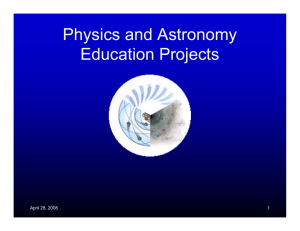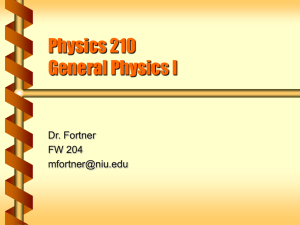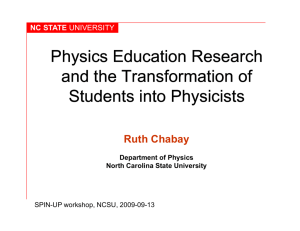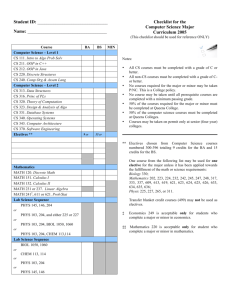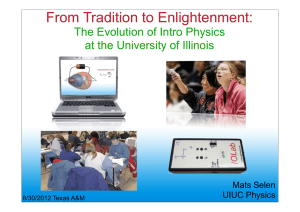117 ± 1
advertisement
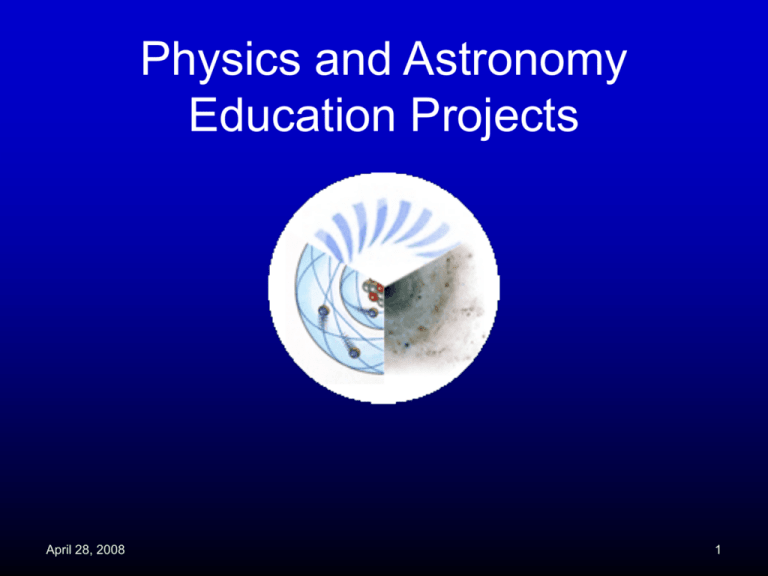
Physics and Astronomy Education Projects April 28, 2008 1 Overview Physics and Astronomy has a long history of exploring innovative ways to teach science. In the last decade, this has included using PRS (“clickers”), computer simulations and Logger Pro and more. In collaboration with CWSEI, we continue to explore and adopt better ways to teach science: • TA training • course transformations April 28, 2008 2 PHAS CWSEI Team Faculty Doug Bonn Jim Carolan Andrzej Kotlicki Chris Waltham Jeff Young (Head) April 28, 2008 STLF James Day Louis Deslaurier Joss Ives (Sept, 08) Peter Newbury Grad Students Joss Ives Sandy Martinuk Mya Warren 3 Teaching Assistant Training Mya Warren, Joss Ives, Sandy Martinuk, Fran Bates We have roughly 40 – 50 new TAs every year, the majority of whom are international students. • They are responsible for the bulk of the teaching in labs and tutorials. • For many students, TAs are the only face-to-face teaching they get with an instructor. • In the past, TAs received no job training on coming to UBC. This was a frightening experience for new TAs (especially international students unfamiliar with our educational system) and a frustrating one for undergraduate students. April 28, 2008 4 What We Did In 2007, the Department instituted mandatory TA training for all new TAs: • The training was created by TAs and is delivered by TAs. • The focus is on practical skills that they can apply directly to teaching physics and astronomy. • A 2-day workshop in Sept, 07 had four themes: our experiences vs. physics education research instructional tools and techniques student assessment diversity and conflict resolution • We created a Mentor TA program, where each new TA was paired with an experienced mentor who was available to give advice and who observed their teaching through the Term to give feedback. April 28, 2008 5 TA Training Evaluation New TAs filled out surveys at the end of… • the workshop Overwhelmingly positive feedback • the Term There is room for improvement in supporting the TAs during the semester and bringing the workshop and the first year classes into harmony with each other. We are also looking at the undergraduate student evaluations of their TAs and investigating new ways of evaluating the teaching abilities of the TAs (and hence the effectiveness of the course.) To learn more about this program, please join the Discussion Session on TA Training at 3:30 p.m. April 28, 2008 6 Course Transformations Pre-CWSEI Phase I courses and activities prior to collaboration with CWSEI identify learning goals, student assessment, strategies to evaluate change Phase II implement transformations, collect feedback ASTR 310 PHYS 100 PHYS 200 PHYS 109 Science One/ Physics ASTR 101/102 PHYS 253 PHYS 101 April 28, 2008 evaluate impact of changes, continue to revise course PHYS 100 clickers PHYS 153 Phase III model for how to teach physics in the context of realworld problems “guinea pig” for developing an archive of information for each PHAS course, accessible to program coordinators, instructors, TAs and students 7 Transformation of PHYS 100 Andrzej Kotlicki, Sandy Martinuk PHYS 100 provides an algebra-based introduction to the fundamental concepts of physics such as force, energy, thermal physics, radiation and electricity. • Audience: Students who did not take Phys 12 in high school: ~ 50% Science, the remainder Arts, Human kinetics, Forestry etc. • Includes laboratory exercises to familiarize students with the physical phenomena and the basic laboratory instruments commonly used to measure them. April 28, 2008 8 What Was Changed? In 2007 the course was taught in context of energy production and consumption focusing on three major themes: home heating and climate change; kinematics and transportation; electricity consumption and generation. • Course and lecture goals were developed. • The content of the course was adjusted to match the goals and themes. • The schedule was switched to weekly labs and tutorials (rather than biweekly) to sync the material with lectures. • The labs were rewritten to more closely follow the scientific method. Several new experiments introduced. • New tutorials consist of groups of 4 working on a single, context-rich problem with group tests every 3 weeks. April 28, 2008 9 What Was Changed? • For a final project, student groups researched and presented 10 minutes involving physics-based evaluation of the real impact of some environmental. April 28, 2008 10 Research Assessments: Colorado Learning Attitudes about Science Survey (CLASS) We surveyed the students’ beliefs about physics. Question 35: The subject of physics has little relation to what I experience in the real world. strongly disagree disagree neutral agree strongly agree expert “favorable” “unfavorable” This question is one of a group of questions that gauge the students’ beliefs about real world connections to physics. April 28, 2008 11 2006 CLASS Results 2006 Real World Connection Beliefs 60.0% 50.0% 40.0% Pre Pre 30.0% Post 20.0% 10.0% 0.0% Favorable April 28, 2008 Neutral Neutral Unfavorable Unfavorable 12 CLASS Results Shift in Favorable Responses Real-World Connection Beliefs 2.0% 0.0% 0.0% % Shift -2.0% -4.0% 2006 2007 -6.0% -8.0% -10.0% April 28, 2008 Was there a smaller decline in 2007? Unfortunately, the results are not statistically significant. 13 CLASS Results CLASS also gauges the students’ confidence in their problem solving skills: Question 34: I can usually figure out a way to solve physics problems. strongly0.0% disagree disagree neutral Shift in Favorable Responses General Problem-Solving Beliefs 2.0% agree strongly agree “favorable” 0.0% -2.0% % Shift -4.0% -6.0% -8.0% -10.0% -12.0% April 28, 2008 2006 2007 The downward trend in students’ attitudes was not only reversed, there was a small increase in the students’ confidence in problem solving. 14 Research Assessments: Problem-Solving Skills Assessment (PSSA) The goal of the PSSA is to isolate and measure different elements of students problemsolving skills (proportional reasoning, algebraic skills, applies real-world knowledge, checks own answers, etc.) The survey is currently undergoing revision and validation. The next version will be administered Fall, 2008. April 28, 2008 Example: This question just looks to see whether students will estimate necessary information using their own experience. Your friend Roger stumbles and falls off the roof of a two storey house. Can you figure out how fast he is going when he hits the ground? If you can, please do. If not, explain why not. 15 Changes for Fall, 2008 • Continue development of lecture material so that it introduces new physics in terms of real-world phenomena before mathematical abstraction. • Refine lab instructions to emphasize application of results to physics in the real world. Introduce “paperless” labs. • Improve context-rich tutorial problems to further encourage productive group interactions. • Improve final projects to encourage more original research. April 28, 2008 16 Transformation of 107/109 Lab Doug Bonn, James Day Freshman Honours Physics lab serve Science One students as well as those who choose to take an enriched, first-year physics program. Term I PHYS 107 (Physics I) Lec Lab Term II Lec Lab PHYS 108 (Physics II) PHYS 109 (Intro to Experimental Physics) Broad goal is to use this course as a crucible for defining what we are trying to achieve in physics laboratories and how best to meet those goals. April 28, 2008 17 Features of 107/109 Lab The lab tackles phenomena the students have not seen in lectures or tutorials. It is not aimed primarily at enhancing material already covered. The experiments are technically simple, with lots of time to explore and “mess about,” but very little formal instruction on how to do things. The aim is to learn what can’t be learned in the classroom: How does a scientist connect theories and models to empirical data? • connection between mathematics and data • data analysis techniques • critical thinking • the roles played by uncertainty and systematic error April 28, 2008 18 107/109 Lab Progress Two terms (Fall 2007, Spring 2008) spent on developing learning goals, plus observing and interviewing the students, have resulted in a preliminary diagnostic tool: • 7 short, paper-and-pencil questions • 1 question using lab equipment April 28, 2008 Example: Student A measures the radioactive particles emitted by a source and reports the decay rate to be 100 ± 10 counts per second. Student B follows the same basic procedure with the same source but counts longer and arrives at a value of 117 ± 1 counts per second. Give an estimate of how long it would take to count 1000 particles. 19 Results Results of Estimation Question devised a mostly-correct scheme for weighting the two counts picked the more precise count (117 ± 1) to make the estimate This was not something explicitly taught: a very high level of thinking averaged or used less-precise count (100 ± 10) to make the estimate Number of Students Diagnostic: The students have been working with uncertainty (failure all year but are unable to assess the relative mode) importance of data with differing uncertainties. April 28, 2008 20 Changes for Fall, 2008 An attempt to step forward on this next year will involve laboratory exercises in which the students themselves will try to create the mathematical tools needed to make statistical inferences about data (cf Schwartz et al., Stanford School of Education). Second version of diagnostic tool will be used for pre- and post-testing next year. Do you have comments and suggestions about the role of labs in the science curriculum? Attend the Discussion Session on Instructional Labs at 2:00 p.m. April 28, 2008 21 April 28, 2008 22 Discussion April 28, 2008 23 Course Archive The goal is to create a long-term, easily-accessible archive of all information pertaining to PHAS courses. • It encourages instructors to develop the course structure (learning goals, student assessment, etc.) • It improves efficiency for course delivery, especially for instructors new to [ the course | teaching ], by providing easy access to teaching resources. • It provides the Department with a form of quality control. • Interaction with students is at the course level, not the individual level (no marks, discussion groups, etc.) April 28, 2008 24 Course Archive Users The users of the archive have different access to certain information and actions: full access read, write most read only* program coordinators current instructors current students TA’s prospective students physics and astronomy education team sysadmin April 28, 2008 new instructors * thru public interface 25 April 28, 2008 26 April 28, 2008 27 Course Goals for PHYS 100 Students should be able to: • Apply conservation of energy and thermal physics principles to realworld thermal systems, such as home heating and climate change. • Apply knowledge of work and Newton's laws to calculate basic dynamics and energy consumption of common transportation systems. • Qualitatively explain how electricity is generated in various types of power plants and the “life cycle” of electricity from production through transmission to consumption, and calculate power consumption for various common circuits. • Use algebra to solve simple equations. • Appreciate that while physics often gives approximate answers, it is very relevant to the real world and is a useful tool for solving problems at the global as well as the personal level. • Develop the inclination and ability to apply problem solving techniques to simplify “real world” problems in terms of simple physics concepts and to compute or estimate solutions. • Recognize that scientific conclusions - whether from an outside source or from your own calculations - may be incorrect, and develop the ability to check these conclusions with simple calculations, 3rd party information, and/or common sense. April 28, 2008 28 April 28, 2008 29 April 28, 2008 30 April 28, 2008 31 April 28, 2008 32 April 28, 2008 33 April 28, 2008 34 April 28, 2008 35 April 28, 2008 36 April 28, 2008 37 April 28, 2008 38 April 28, 2008 39
